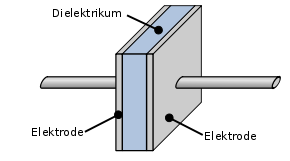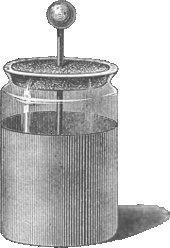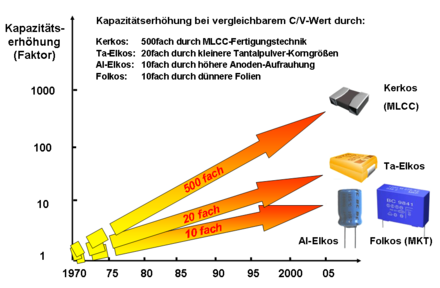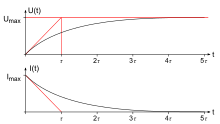Capacitor
![]()
This article describes electrical capacitors with conventional dielectric. Electrochemical capacitors with double-layer capacitance and pseudocapacitance are described under supercapacitor.
A capacitor (from Latin condensare 'to condense') is a passive electrical component with the ability to statically store electrical charge and associated energy in an electric field in a DC circuit. The charge stored per voltage is called electrical capacitance and is measured in units of farads. In an AC circuit, a capacitor acts as an AC resistor with a frequency-dependent impedance value.
In principle, capacitors consist of two electrically conductive surfaces, the electrodes, which are separated from each other by an insulating material, the dielectric. The size of the capacitance is determined by the area of the electrodes, the material of the dielectric and the distance between the electrodes. The electrodes and dielectric may be coiled or connected in parallel as a stack. Industrially manufactured capacitors are supplied with capacitance values from about 1 picofarad (10-12 F) to about 1 farad, and up to 10,000 farads for supercapacitors.
By far the most widely produced capacitors are integrated storage capacitors in digital storage circuits. The most important capacitor types are ceramic capacitors, plastic film capacitors, aluminum and tantalum electrolytic capacitors and, although they are based on completely different storage principles, supercapacitors. In addition to these capacitors with fixed capacitance values, there are devices with adjustable capacitance values, the variable capacitors.
Capacitors are used in many electrical systems and in almost all electrical and electronic devices. For example, they implement electrical energy storage as DC link capacitors in frequency converters, as storage capacitors in sample-and-hold circuits or as photo flash capacitors in flash light devices. They couple signals in crossovers of audio equipment and, as highly stable class 1 capacitors, form filters and oscillating circuits together with coils. As smoothing capacitors in power supplies and support capacitors in digital circuits, they are found in the field of power supply. As interference suppression capacitors, they suppress electromagnetic interference signals, and as power capacitors, they provide desirable phase compensation. Special designs of capacitors are used as sensors.
Unwanted capacitive interference coupling from electric fields of adjacent components in circuits and parasitic capacitances, so-called stray capacitances, do not belong to capacitors. Nor do capacitors include a number of actuators such as piezoelectric transducers, electrostatic loudspeakers, deflection plates and electro-optics components.

Schematic diagram of a capacitor with dielectric
How it works
A capacitor blocks the direct current but passes on the alternating current.
Functionality in the DC circuit
After applying a DC voltage to a real capacitor with series resistor, a monotonic electric current flows which charges the electrodes with opposite polarity, so that a constantly increasing voltage builds up in the capacitor. The electric potential building up on the electrodes causes an electric field to develop in the space between the electrodes, the field strength of which is proportional to the voltage built up.
In the case of a DC voltage source with constant internal resistance, the voltage at the capacitor here follows an exponential function with a negative exponent, so that the current asymptotically approaches zero over time. If the voltage source and capacitor have the same voltage, then no current flows ("the capacitor is charged").
When the capacitor is disconnected from the voltage source, the energy and charges are conserved and the voltage remains constant. In general terms, this means that the charge on the electrodes is stored by the capacitor. If energy is taken from the capacitor by connecting a load, then the field strength of the electric field decreases and so does the capacitor voltage.
Since in a closed circuit the current flows throughout the circuit, it also flows through the capacitor. Physically, however, the current in the circuit consists of two currents, a conducted current of charge carriers such as electrons or ions and a so-called displacement current in the space between the electrodes, which is to be understood as part of the effect of the electric field and is accompanied by a corresponding change in electric field strength. In real capacitors, the space between the electrodes is filled with a dielectric. The displacement current then results, in addition to the part due to the change in field strength, from the charge displacement in the dielectric, the polarization, which results from its dielectric constant.
For small field strengths and linear dielectric materials, the polarization grows linearly with the voltage across the capacitor. The charge stored in the capacitor grows proportionally to the voltage. The constant of proportionality is called capacitance; it is the essential characteristic of a capacitor. The larger the capacitance 


respectively
and
summarize that. 



Real capacitors can only be charged up to a maximum permissible voltage, which results from the dielectric strength of the dielectric.
The time a real capacitor needs to charge up or to be discharged can be taken from the article RC element.
Functionality in the alternating current circuit
Capacitors pass on alternating voltages and alternating currents in the alternating current circuit, but with a shift in the phase position between voltage and current; the current precedes the voltage by 90°. This is because, due to their charge storage capability, a current begins to flow in capacitors before the voltage changes, whereas in an inductor the voltage changes before a current flows. Mnemotechnics:
- At the capacitor: current rushes ahead.
- For inductors: currents are delayed.
A capacitor with capacitance 





The magnitude of the complex impedance 

The impedance is smaller the larger the capacitance and the higher the frequency.
The property of capacitors as AC resistors with the lowest possible impedance is used not only for energy storage but also in many applications for the separation of DC and AC components, for the correction of phase shifts and for the generation of resonant circuits. The discharge differential equation, which is important for many applications, can be found in the article RC element.

Phase shift between current and voltage on a capacitor
History
Leyden jar
→ Main article: Leyden bottle
The Leiden flask is the oldest type of capacitor (capacity about 5 nF). It consists of a glass vessel covered inside and outside with metal foil, usually aluminium. The glass acts as an insulator, later called "dielectric". The principle of the Leiden bottle was found independently in 1745 by the cathedral dean Ewald Jürgen Georg von Kleist in Cammin (Pomerania) and a year later by the physicist Pieter van Musschenbroek in Leiden, when they suffered electric shocks during laboratory experiments with arrangements of glasses and metal parts.
The Leiden flask and similar laboratory devices were subsequently used primarily for public demonstrations of electric shocks (also known as "Kleist's shock"), and later, as knowledge of the nature of electricity increased, as a source of energy for more advanced experiments: Benjamin Franklin connected a Leyden jar via a metal cord to a kite, which he launched into the sky. With this dangerous experiment, he succeeded in transferring charge from thunderclouds to the Leyden jar. He coined the term "electrical condenser".
Further development
An improved capacitor was invented in 1775 by Alessandro Volta (1745-1827), who called it "electrophorus" (electrophore, carrier of electricity). It consisted of two metal plates insulated from each other by a layer of ebonite. This arrangement can already be considered the prototype of modern capacitors. The use of better dielectrics later led to a reduction in size. Around 1850, mica, a naturally occurring mineral, was sliced and used as an insulator; commercially, these capacitors were produced from the time of World War I onwards. Wound paper capacitors with metal foil facings have been in use since 1876.
Capacitors that resulted in capacitors with higher capacitance through the chemical construction of an extremely thin dielectric of non-conductive aluminium oxide on an aluminium anode and the use of a liquid electrolyte, the later "electrolytic capacitors", were patented in 1896 by Charles Pollak. They were initially used as filter capacitors to suppress humming noises in telephone networks.
Since about 1900, porcelain was also used as a dielectric in capacitors. It was not until the 1930s that the development of ceramic capacitors took place as a result of research into other ceramic materials to replace porcelain and mica.
Mica as a dielectric in capacitors was first used by William Dubilier in the USA in 1909 and was the most widely used material for capacitors in communications equipment until the outbreak of World War II. Nowadays, mica capacitors have been replaced by improved class 1 ceramic capacitors.
With the development of high quality insulating plastic films from the field of organic chemistry after World War II, the industry began to replace the paper in metal-paper capacitors with thinner and more voltage-resistant plastic films, which evolved into a wide range of different plastic film capacitors.
From around 1950, General Electric in the USA began developing tantalum electrolytic capacitors. Here, it was not only possible to achieve miniaturization through a considerably higher capacity per construction volume compared to the previously known capacitors, but with the development of a solid electrolyte, the long-term stability of electrolytic capacitors could also be significantly improved.
Another significant increase in capacitance was achieved with the "low voltage electrolytic capacitor" patented by General Electric in 1957, which was further developed into a marketable component by SOHIO and, from 1971, by NEC, and initially received the designation "double-layer capacitor", which now became the designation supercapacitor due to the findings on pseudocapacitance.
Silicon capacitors are a more recent development. These result from the semiconductor industry's extensive experience with structuring silicon and offer the user frequency-stable capacitance values up into the gigahertz range.
In recent years, there has been a development in all suitable capacitor types towards ever smaller construction volumes and surface-mountable (SMD) capacitors. In addition, a considerable increase in electrolyte conductivity and correspondingly lower loss resistances have been achieved, especially for aluminum and tantalum electrolytic capacitors, through the introduction of new polymer electrolyte systems.
Current (2009) research is concerned, among other things, with new surface structuring of the electrodes. For example, a nanostructure in the form of billions of small holes next to each other in a thin aluminium layer, coated with titanium nitride/aluminium oxide/titanium nitride as a capacitive structure, can increase the power density of a nanocapacitor, measured in W/kg, by more than ten times compared to electrolytic capacitors and thus achieve a storage capacity in the order of magnitude of double-layer capacitors without exhibiting their disadvantage, the limited charging or discharging speed.
Another way to increase capacitance is to use better dielectrics. This is achieved, for example, by incorporating barium titanate into a non-conductive matrix, which results in a higher permittivity than with ceramic capacitors, while the dielectric remains robust and malleable as with film capacitors.
Market
Capacitors are found in almost all electrical and electronic equipment. According to the estimate of an industry report, in 2008 the value of all capacitors sold worldwide amounted to US$ 18 billion. Of this, ceramic capacitors accounted for US$8.3 billion (46%), aluminum electrolytic capacitors US$3.9 billion (22%), plastic film and metal paper capacitors US$2.6 billion (15%), tantalum electrolytic capacitors US$2.2 billion (12%), double layer and super capacitors US$0.3 billion (2%), and other capacitors such as vacuum capacitors US$0.7 billion (3%). In particular, the development in the field of new telecommunication devices and tablet computers with their MLCC chip capacitors has significantly driven the market. Of the approximately 1.4 trillion (1.4-1012) capacitors (2008), MLCC chips alone accounted for approximately 1 trillion (1.0-1012) units.
The market for industrially produced capacitors and those required by industry has declined somewhat in the following years, because in many cases more expensive capacitors have been replaced by cheaper solutions. For example, tantalum chips were replaced by MLCCs. The capacitor market was estimated at US$16.9 billion in 2016.

Leyden jar

Miniaturization in electronics has been achieved not least through miniaturization in capacitors. The volume efficiency of a ceramic capacitor, for example, could be increased by a factor of about 500 with the same C/V value through further development in manufacturing technology towards MLCC ceramic capacitors.
Questions and Answers
Q: What is a capacitor?
A: A capacitor is an electronic device that stores electric energy. It is similar to a battery, but can be smaller and lighter, and charges or discharges much quicker.
Q: What was one of the first capacitors invented?
A: The Leyden jar was one of the first capacitors invented.
Q: How do capacitors store energy?
A: Capacitors store energy inside an electrical field created by two metal plates that are on top of each other and near each other, but that do not actually touch. Sometimes, other shapes of capacitors are used for special purposes. A capacitor-like effect can also result just from two conductors being close to each other, whether you want it to exist or not.
Q: What type of capacitor should be used depending on the application?
A: The type of capacitor used depends on the application. Capacitors come in many sizes and some are adjustable.
Q: How many connections does a capacitor have?
A: All capacitors have two connections, or leads.
Q: Is it easy to replace most kinds of capacitors?
A: Most kinds of capacitors can be replaced easily by someone who has basic skills in electronics. However, one of the more powerful types - the electrolytic capacitor - must be used correctly or they can explode violently.
Q: What makes a capacitor different from a battery?
A:Capacitor charges or discharges much quicker than batteries and they can release all their stored energy very quickly, even faster than a second whereas batteries take longer time to discharge their stored power
Search within the encyclopedia





